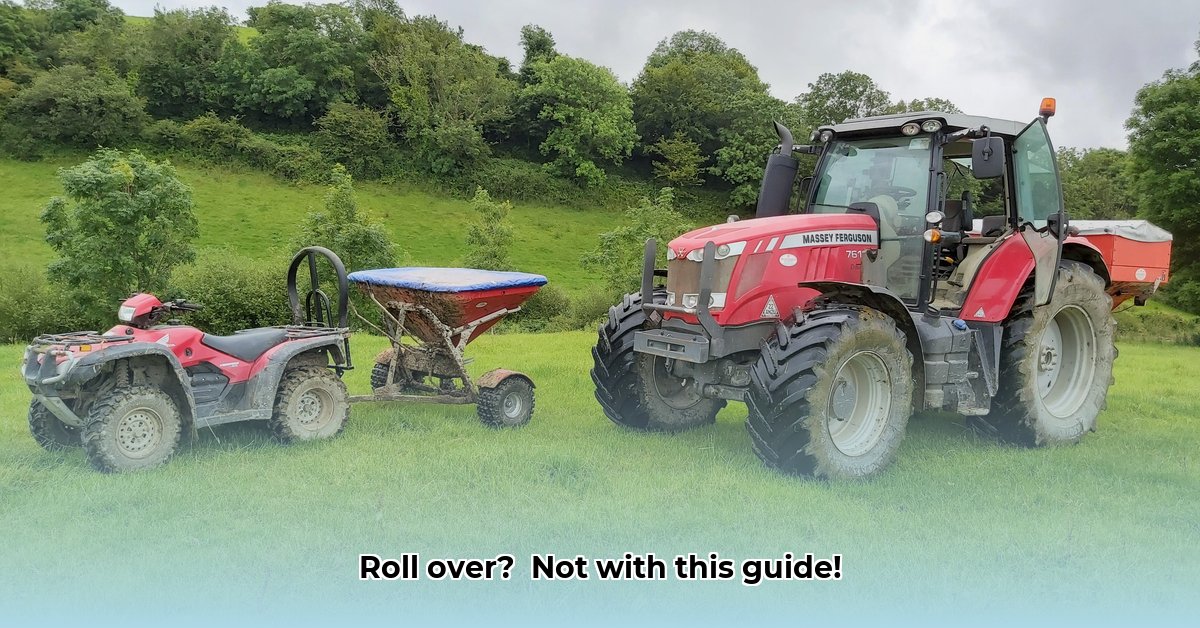
Tractor rollovers are a leading cause of serious injury and death in agriculture. A Roll Over Protective Structure (ROPS), commonly known as a roll bar, is a crucial safety device designed to protect the operator in the event of a rollover. This guide provides comprehensive instructions for selecting, installing, and maintaining a ROPS for optimal tractor safety. For more information on top tractor links, see this helpful resource.
Understanding the Critical Role of ROPS
Every year, countless agricultural workers suffer injuries due to tractor rollovers. While precise statistics are difficult to obtain, the potential for severe harm underscores the absolute necessity of ROPS. OSHA standards (specifically 1928.51) emphasize the importance of ROPS, often mandating their use in many work environments for tractors exceeding specific horsepower and manufacturing years. Don't let statistics define your future; prioritize safety with a ROPS.
Choosing the Right ROPS for Your Tractor
Selecting a properly fitting ROPS is paramount to its effectiveness. A poorly fitting or incompatible ROPS offers minimal protection. Consider these key factors:
Tractor Compatibility: The ROPS must be designed for your specific tractor make, model, and year. Consult your owner's manual or the manufacturer's website for compatibility information. Improper fit can compromise safety.
Weight Capacity: The ROPS' weight capacity rating must exceed your tractor's gross weight, including any added implements or loads. Overloading weakens the structure and diminishes its protective capabilities.
Certification: Ensure the ROPS carries the necessary safety certifications, indicating it has undergone rigorous testing and meets established standards. Look for certifications from recognized organizations. This verification assures the ROPS will perform as intended in a rollover.
Step-by-Step ROPS Installation Guide
Following the manufacturer's instructions is crucial. The steps below provide a general overview; always refer to your specific ROPS and tractor manuals for precise details.
Preparation: Gather all necessary tools and materials as specified by the manufacturer. Clear a safe, level workspace, and wear appropriate safety gear (safety glasses, gloves, etc.). Having a helper can be beneficial for handling heavier components. Review all instructions before beginning.
Base Attachment: Carefully align and firmly fix the ROPS base to your tractor's designated attachment points. Use the supplied hardware and tighten connections securely, but avoid over-tightening, which can damage components.
Structure Assembly: Assemble the ROPS structure according to the manufacturer's instructions, ensuring proper alignment and secure connections at each stage. Use torque wrenches if the instructions specify, to ensure consistent tightening and prevent component failure.
Final Inspection: Upon completion, conduct a thorough visual inspection for loose parts, misalignments, or any signs of damage. Recheck all connections for tightness.
Seatbelt Verification: Ensure your tractor's seatbelt is in good working order and properly secured; the ROPS is only effective when used in conjunction with a properly functioning seatbelt.
ROPS Maintenance: A Lifelong Commitment to Safety
Regular maintenance preserves the integrity and effectiveness of your ROPS.
- Visual Inspections: Perform regular visual inspections for corrosion, cracks, loose bolts, or any signs of damage or deformation. A quick check can prevent disaster.
- Cleaning: Keep the ROPS clean, removing accumulated dirt, debris, and corrosive materials. Regular cleaning and lubrication can add to structural durability.
- Bolt Tightness: Periodically check the tightness of all bolts and fasteners. Replace any worn or damaged hardware promptly.
- Welding Integrity: If welding is involved in ROPS construction, periodic assessment by a qualified welder is recommended to ensure the integrity of the welds.
Troubleshooting Common ROPS Issues
During installation or use, you might encounter some challenges. Refer to your manual first. If you continue to have problems, consider consulting a professional mechanic.
Aligning the ROPS: Difficulty aligning the ROPS often stems from incorrect measurements or improper sequence of installation steps. Re-check the instructions, referencing diagrams and step-by-step guides as needed.
Loose Bolts: This indicates incomplete tightening of bolts and fasteners. Re-tighten all connections to the manufacturer's specifications.
Damaged Components: If any components are damaged, replace them. Using damaged components compromises the structural integrity and protective capabilities of the ROPS.
Fit to Tractor: If the ROPS doesn't fit properly, double-check that you’ve ordered the correct ROPS for your tractor model.
Where to Purchase Certified ROPS
Purchase your ROPS only from authorized dealers, reputable agricultural equipment suppliers, or directly from the manufacturer. Verify that the supplier carries certified ROPS that meet relevant safety standards. Remember, investing in certified equipment is an investment in your safety.
This guide provides fundamental knowledge. Always defer to your specific ROPS and tractor manuals for detailed instructions and safety information. Your safety is paramount, make it a priority.